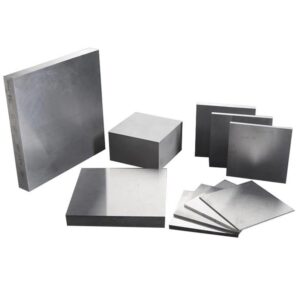High-density tungsten sheets are widely used in aerospace, nuclear, defense, electronics, and medical industries due to their exceptional physical properties, such as a high melting point (~3422°C), superior density (~19.3 g/cm³), and excellent resistance to radiation and wear. But how do you determine the right thickness for a given application? Choosing the appropriate thickness of a high-density tungsten sheet directly impacts performance, safety, and cost-effectiveness.
| Property | Tungsten | Lead | Molybdenum | Steel |
| Density (g/cm³) | ~19.3 | ~11.3 | ~10.2 | ~7.8 |
| Melting Point (°C) | ~3422 | ~327 | ~2623 | ~1370–1510 |
| Radiation Shielding Effectiveness | Excellent | Good | Moderate | Low |
| Mechanical Strength (MPa) | ~800–880 | ~17 | ~550–620 | ~400–600 |
| Brittleness | Brittle (esp. thin) | Ductile | Brittle | Ductile/Moderate |
| Cost (relative) | High | Low | Moderate | Low |
This comparison highlights tungsten’s unique advantages in high-density and high-temperature applications, while also pointing out limitations such as brittleness and cost.
At Heeger Metals, we specialize in high-density tungsten sheets, ensuring optimal performance for industrial and scientific applications.

What Are the Key Properties of High-Density Tungsten Sheets?
High-density tungsten sheets are known for:
- Exceptional Density: ~19.3 g/cm³, providing excellent radiation attenuation.
- High Melting Point: One of the highest among all metals (~3422°C).
- Mechanical Strength: Strong under compression; ideal for load-bearing or impact-resistant applications.
- Thermal Conductivity: Efficient heat distribution with low thermal expansion.
- Corrosion and Wear Resistance: Maintains integrity in harsh environments.
Where Are High-Density Tungsten Sheets Commonly Used?
- High-density tungsten sheets serve a variety of roles across different sectors:
- Aerospace: Vibration damping, radiation shielding, and mass balancing.
- Nuclear Power and Research: Radiation shielding, neutron absorption (in combination with other materials).
- Medical Devices: Imaging equipment, radiation collimators, and cancer treatment shielding.
- Electronics: Heat spreaders in semiconductors and vacuum furnace parts.
- Defense: Armor plating and kinetic energy penetrators.
How Does Thickness Affect Key Performance Metrics?
| Thickness (mm) | Effective Density (g/cm³) | Tensile Strength (MPa) | Gamma Shielding (80 keV) | Thermal Conductivity (W/m·K) |
| 0.3 | 17.9 | ~680 | ~60% | ~130 |
| 0.5 | 18.2 | ~720 | ~75% | ~140 |
| 1.0 | 18.7 | ~800 | ~90% | ~160 |
| 2.0 | 19.1 | ~850 | ~96% | ~170 |
| 5.0 | 19.25 | ~880 | >99% | ~175 |
Note: Performance values may vary depending on manufacturing method and alloy purity.
What Factors Influence Tungsten Sheet Thickness Selection?
Selecting the right tungsten sheet thickness requires balancing several criteria:
- Application Requirements: Does the project demand high radiation shielding, thermal management, or mechanical durability?
- Mechanical Strength: Thicker sheets improve load-bearing capabilities but may reduce flexibility.
- Thermal Conductivity: Thicker tungsten retains heat longer, while thinner sheets cool faster.
- Electrical Properties: Sheet thickness can affect electrical resistance and conductivity in sensitive components.
- Weight Constraints: Aerospace and portable medical devices often require thinner, lighter sheets.
- Manufacturing Complexity: Thinner sheets are harder to machine and more prone to fracture.
- Cost: Thicker sheets use more raw material, but thinner ones may incur higher fabrication costs due to precision processing.
How to Match Tungsten Sheet Thickness to Application Needs?
Choosing the correct thickness depends on a careful analysis of your application’s specific requirements:
- Analyze the Operating Environment: Consider temperature, pressure, radiation exposure, and weight limits.
- Balance Performance and Budget: Sometimes, a slightly thicker sheet offers significantly better performance for only a marginal cost increase.
- Consider Manufacturing Limitations: Extremely thin sheets (<0.5 mm) may require specialized handling or lamination.
| Application | Recommended Thickness (mm) | Reason |
| Aerospace Radiation Shielding | 1.0 – 3.0 | Balance of shielding with weight efficiency |
| Nuclear Barrier Panels | 3.0 – 10.0 | Maximum radiation protection and strength |
| Semiconductor Heat Spreaders | 0.3 – 1.0 | Thin for thermal conductivity in tight spaces |
| Medical Imaging Devices | 1.0 – 2.0 | Effective shielding without bulk |
| Counterweight/Ballast | 2.0 – 5.0 | High-density mass with structural resilience |
Request a custom quote for High-Density Tungsten Sheets.
What Are Common Mistakes When Choosing Tungsten Sheet Thickness?
- Overestimating Thickness: Using an overly thick sheet can lead to unnecessary weight and cost.
- Underestimating Thermal Needs: Choosing a thin sheet in high-temperature settings can result in warping or failure.
- Ignoring Processing Challenges: Thin sheets may crack during cutting or bending if not handled properly.
How to Avoid These Issues?
- Use performance modeling and simulations.
- Consult with tungsten materials experts.
- Request prototypes or test samples when possible.
Explore our high-density tungsten sheets.
Conclusion
Choosing the right thickness for a high-density tungsten sheet is a multifaceted decision. It involves assessing the mechanical, thermal, and shielding requirements of the application while considering fabrication challenges and budget constraints. A thinner sheet might suit compact electronics, whereas a thick sheet is indispensable for nuclear shielding.
Heeger Materials offers high-density tungsten sheets in customizable thicknesses and consistently high quality to meet your specific engineering and industrial needs.
Looking for high-density tungsten sheets? Contact us today!

